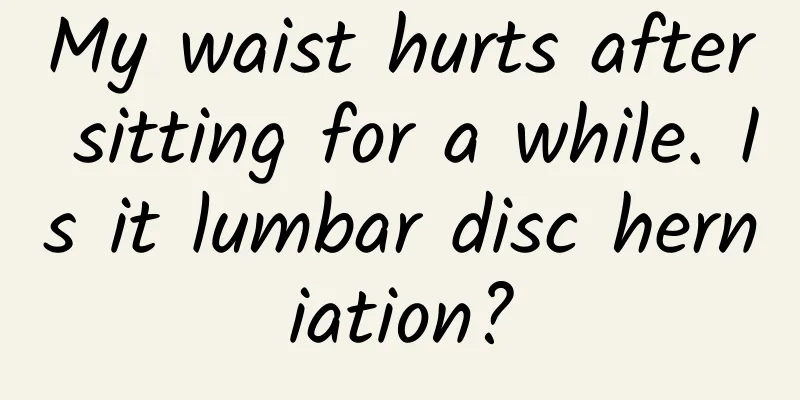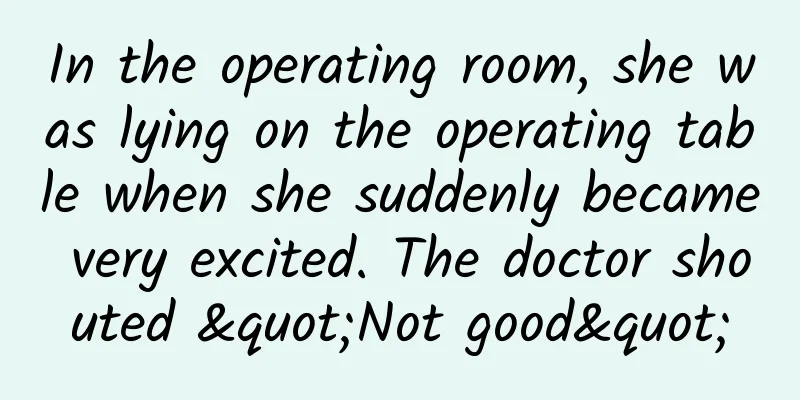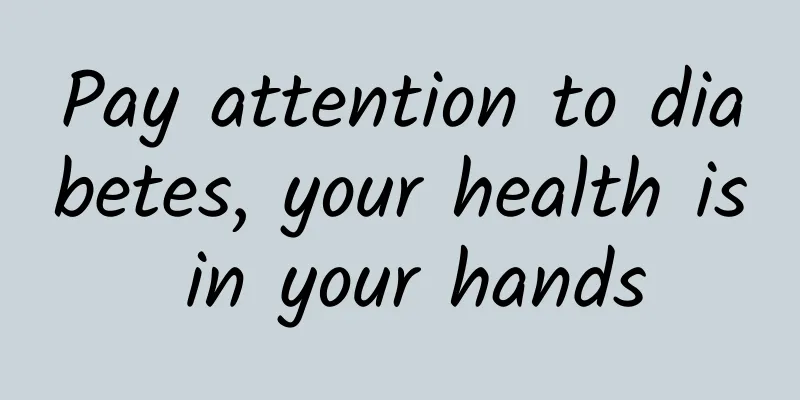My waist hurts after sitting for a while. Is it lumbar disc herniation?

|
This is the 3439th article of Da Yi Xiao Hu As the pace of society accelerates, people's work pressure continues to increase, and everyone jokingly calls themselves "workers". For workers, the body is the capital of the revolution. Under such a working mode, especially office white-collar workers, due to long-term sitting, they often have some discomfort in the waist and back, and even suffer from lumbar disc herniation. In recent years, the average age of patients with lumbar disc herniation has even gradually decreased. This has caused panic among many young people. Many people do not even have lumbar disc herniation. Due to a little discomfort or pain in the waist and back, they also suspect that they have this disease. In fact, lumbar disc herniation is only one of the causes of low back pain. When low back pain is only limited to a local area and there is no radiating pain in the legs or buttocks, the possibility of lumbar disc herniation is not great, and there is no obvious compression of the lumbar nerves. So how do you self-judge whether you have lumbar disc herniation? The following is a method that you can simply judge by yourself, so that you can try it at home without too much anxiety. If you find abnormalities in the self-test, you can also go to the hospital as soon as possible. How to self-diagnose whether you have lumbar disc herniation? This test is also used by our doctors on a daily basis and is called the straight leg raise. First, lie flat on a hard surface, which can be a yoga mat on the ground or a hard bed. Keep your whole body relaxed and stretch your legs. At this time, an assistant is needed to lift your left leg and right leg in turn. During the lifting process, the knee joint needs to be kept straight. If pain or numbness in the calf or buttocks occurs when any leg is lifted and the angle with the lying plane is not 60°, it means that the person being tested is very likely to have lumbar disc herniation and needs to go to the hospital for further examination. It should be noted that if pain or numbness in the calf or buttocks occurs during the test, the test should be stopped immediately to avoid multiple damage to the nerves. Straight leg raising test (Drawing: Frank H. Netter) If it is not possible to lie down, this examination can also be completed while sitting. The assistant holds the heel of the person being examined, gradually straightens the knee joint, and lifts the lower limb upward. When the herniated disc compresses the nerve, the patient will reflexively lean back and straighten the hip joint to relieve sciatica. This method can be used to make a preliminary and simple self-test to determine whether you have lumbar disc herniation. This test is most common and characteristic in lumbar disc herniation at the L4-5 and L5-S1 segments, which have the highest incidence. Of course, even if the above symptoms do not appear in the test, if the pain in the waist and back persists or even becomes more severe, you should go to the hospital for treatment. What should I do if I often have lower back pain? For the "sedentary people", if you often sit for a while, or stand for a long time, or bend over and have back pain, and the back pain is relieved or disappears after bed rest, and can be temporarily relieved after conservative treatments such as hot compresses and massages, then you may have "chronic nonspecific low back pain". This kind of low back pain may last for a long time, even more than 12 weeks. No organic problems were found in the X-rays taken at the hospital. Physical examinations found increased muscle tension or obvious localized tenderness points (trigger points) in the painful area. Then you may need to reduce your sitting time and maintain proper exercise. If you can also do some special training to strengthen the waist and back muscles, it would be even better. This can not only reduce the frequency of low back pain, but also prevent lumbar disc herniation. When working, remember to get up and move around every hour or so, and pay attention to the correct sitting posture, not crossing your legs. The World Health Organization recommends that adults take at least 2 days a week to do moderate-intensity exercise. Next, I will introduce to you a few exercises to exercise the waist and back muscles. You can do them at home. I hope you will stick to the exercises and stay away from back and leg pain. First exercise: Supine straight leg raise Exercise content: iliopsoas, quadriceps, rectus abdominis, internal obliques, external obliques, transverse abdominis Lie flat on your back parallel to the ground, raise one leg to more than 60 degrees, then put it down, and do the same with the other leg, alternating legs. Key points of this section: Repeat the above movements 16 times in a row. When the legs are lowered, the knee joints cannot bend. The second action: Lie down and raise your legs Exercise content: rectus abdominis, internal oblique muscles, external oblique muscles, transverse abdominal muscles, iliopsoas muscles Lie flat on your back parallel to the ground, lift your legs together, try to keep them at 90 degrees to the ground, exert force on your lumbar spine, and lower your legs back to their original position. Key points of this section: Repeat the above movements 8 times in a row. When lowering the legs, the knee joints cannot bend. The third action: five-point support of the back bridge Exercise content: erector spinae, multifidus, rectus abdominis, internal obliques, external obliques, transverse abdominis Bend your legs together and place your hands on both sides of your body for support. Raise your back and hips to form a bridge position. Hold for a few seconds and then lower. Key points of this section: Repeat the above movements for 2 sets, 8 times each set. Lift your abdomen as high as possible, keep your shoulders, hips, and knees in a straight line, and maintain the arch bridge position for more than 5 seconds. The fourth movement: Xiaoyan Fei head and chest stretch Exercise content: erector spinae, multifidus Lie flat on your back parallel to the ground, cross your hands behind your back. Use your lumbar spine to lift your head and chest, and stretch your back as far as possible. Hold for a few seconds, then put it down. Key points of this section: Repeat the above movements for 2 sets in a row, 8 times in each set, lift your chest off the bed as much as possible, and keep your head and chest extended for more than 5 seconds. The fifth movement: Xiaoyanfei overall stretch Exercise content: erector spinae, multifidus, gluteus maximus Lie flat on your back parallel to the ground, stretch your right hand and left leg as far back as possible, raise them 30 degrees, put them down, and then switch to your left hand and right leg. You can rest for 10 seconds in between. Key points of this section: Repeat the above movements 16 times in a row, extending your forearms as far forward as possible and raising your thighs as high as possible. The sixth action: plank support and leg lift Exercise content: erector spinae, multifidus, deltoid, gluteus maximus, biceps femoris, rectus abdominis, internal obliques, external obliques, transverse abdominis Lie flat on your back parallel to the ground, with your hands shoulder-width apart, and use your arms to support your body. Do a plank-like position, and alternately lift your legs slowly, put them down, and return to their original positions. Key points of this section: Repeat the above movements 8 times in a row, keeping the head, shoulders, hips and ankles in a straight line, and lift the thighs as high as possible. Author: Chen Fancheng, Li Juan, Lin Hong Instructor: Dong Jian Unit: Department of Orthopedics, Zhongshan Hospital Affiliated to Fudan University Institute of Medical Science Popularization, Fudan University This article was funded by the following project: Shanghai Science and Technology Commission Science Popularization Project (No.: 20DZ2312000) Shanghai Municipal Health Commission Outstanding Academic Leader Project (No.: GWV-10.2-XD11) |
<<: Why do maple leaves turn red? What kind of people do maple leaves symbolize?
Recommend
How to lighten the areola and solve your problems
Some women have very dark areolas. The normal are...
What are the dangers of gynecological cervical hypertrophy?
Every woman will have leucorrhea secretion, becau...
Do probiotics really work?
Are bacteria really harmful and useless? The answ...
How many days does the drug abortion have a reaction?
Medical abortion is a method of terminating pregn...
Treatment of endometriosis bleeding
When it comes to endometriosis, many people are f...
What could be the problem if I feel discomfort in my lower abdomen on the right side?
The structure of the human body is very ingenious...
Why do pregnant women have headaches and sore feet?
We all know that pregnant women will experience s...
What are the causes of high cholesterol during pregnancy?
Because the physical health problems of pregnant ...
What should I do if I have cysts during pregnancy? It is important to find out the condition!
Nowadays, many young women do not do physical exa...
The number of primary and secondary school students suffering from scoliosis in my country has exceeded 5 million. How to prevent and treat it?
When we describe a person as being in high spirit...
What is bloody and purulent leucorrhea? That's the situation
Under normal circumstances, women's leucorrhe...
Vaginal itching and pain should not be ignored
The genitals are a part that women are ashamed to...
Will loquat honey crystallize? What does loquat honey taste like?
Loquat honey is transparent in color and has a li...
Can I eat cantaloupe during confinement?
The month after delivery is an important period f...
Contact for 10 seconds can cause infection, and severe cases can cause liver damage! The recent high incidence of the virus has caused the China Centers for Disease Control to issue a series of warnings →
As spring arrives and the temperature rises, are ...









